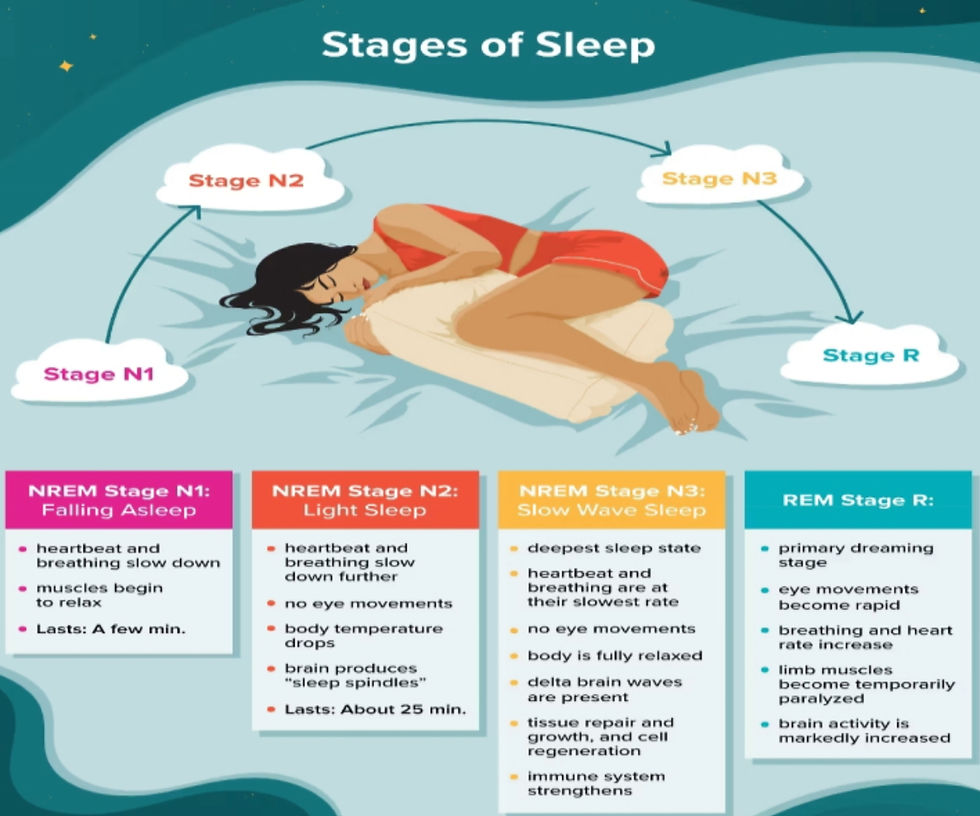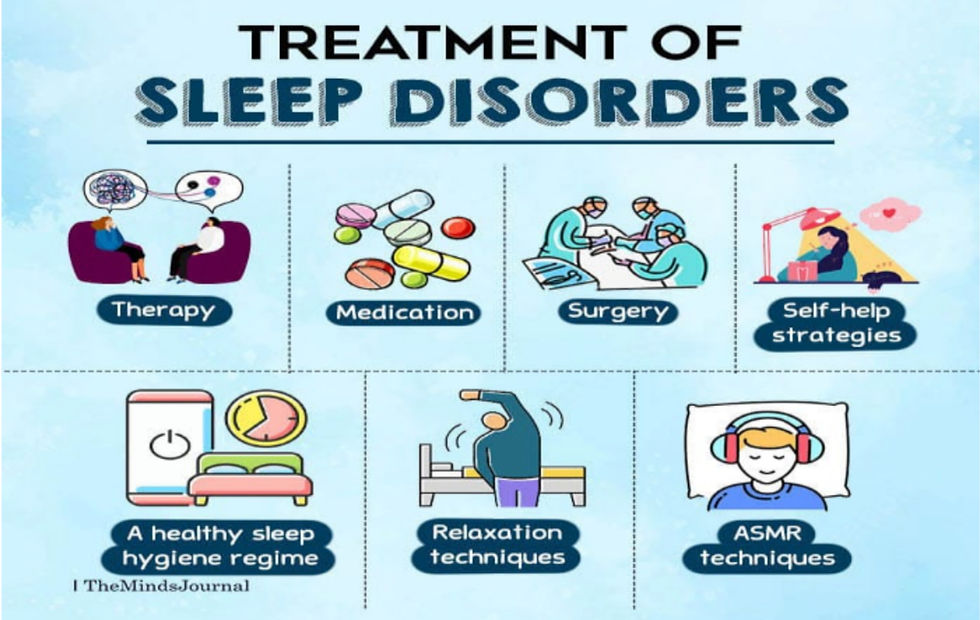Sleep Science
- sciforum

- Sep 11
- 6 min read
Table of Contents:
Abstract
Introduction
Stages of Sleep
Conditions and Disorders
Causes of Sleep Disorder
Treatment of Sleep Disorders
Conclusion
References
Abstract:
Sleep is a complex and dynamic yet normal process that allows your body and brain to rest. At first glance, sleep appears to be deceptively simple.
For most people, it’s simply a matter of getting comfortable, closing their eyes, and drifting into slumber. But despite how simple it seems, sleep is one of the most complex and mysterious body processes. It is important for a number of brain functions, including how nerve cells (neurons) communicate with each other. In fact, your brain and body stay remarkably active while you sleep.
Sleep science is the study of sleep and its effects on the body, brain, and behaviour. Understanding sleep science can help us appreciate the importance of sleep for overall health and well-being. This article aims to make you better informed about mechanisms and different stages of sleep, disorders you might face when you don’t get a good sleep, and what practices you can inculcate in your daily life for a peaceful sleep.
Introduction:

Sleep is an active, essential process that restores the body, strengthens immunity, regulates emotions, and supports memory and learning. It occurs in cycles of NREM (light to deep restorative sleep) and REM (dreaming, brain activity, emotional processing). A full cycle lasts 90–120 minutes and repeats through the night, making quality sleep vital for overall health and well-being.
Sleep, once viewed as a passive state, is now recognized as a dynamic process vital for physical and mental health. Its history spans ancient observations, pre-industrial biphasic patterns, and modern sleep science driven by brainwave studies. Sleep is regulated by circadian rhythms and homeostatic processes, with disruptions from factors like light exposure, shift work, or jet lag. Over 80 sleep disorders exist—including insomnia, sleep apnea, narcolepsy, and parasomnias—each affecting sleep quality, timing, or duration. Causes range from medical and mental health conditions to genetics, lifestyle, and medications. Treatments include sleep hygiene, cognitive therapy, medication, and light therapy. Poor sleep increases risks of depression, hypertension, lowered immunity, and metabolic issues, highlighting its essential role in overall well-being.
HISTORY OF SLEEP :
The science of sleep has come a long way and has changed significantly over the years. Initially, sleep was considered a near-death experience. The history of sleep is marked by Ancient Indian sages, Egyptian, Greeks and romans observations recognizing its importance for health, a pre industrial biphasic sleep pattern that shifted to a monophasic one after the industrial revolution and the advent of artificial light, and the modern scientific study of sleep, which began with brainwave recordings in the 20th century and continues today with research into its functions and the development of sleep medicine and therapy.
Stages of Sleep:
Sleeping doesn't mean your brain is totally inactive. While you are less aware of the world around you, you still have plenty of detectable brain activity. The brain has predictable patterns.
During sleep, our body goes through 2 phases, which are:-
REM (rapid eye movement)
NERM (non rapid eye movement)
NERM has 3 stages which are stage 1 ,stage 2, stage 3. One cycle normally takes 90 to 120 minutes before beginning of another stage .

NREM
In this stage sleep appears to occur in virtually all humans . Most people spent more time in this stage in the first half of the night. Let's take a closer look at it's different stages.
Stage 1
It is the lightest stage of sleep you enter in this stage right after you fall asleep this sleep stage is when heartbeat ,eye movement, brain waves and breathing activity begin to taper down. Motor movements also diminish, although you may experience muscle twitches called hypnic jerks. After that ,your sleep gets deeper, and you move into the stage 2.
Stage 2
It is still light sleep ,but deeper than stage 1. During this stage ,your brain waves slow down and have noticeable pauses between short, powerful bursts of electrical activity. However, this sleep stage is also marked by the appearance of two unique types of brain activity:
Sleep spindles
K- complexes
Stage 3
It is the last stage of NREM phase in which the brain waves are slow but strong . In this stage body repairs injuries and reinforce your immune system. It is the deepest stage of NREM sleep takes about 25% of your total sleep time in adults.
It is much more difficult to awaken someone from sleep during stage 3 than during earlier stages. Interestingly, individuals who are more often associated with wakefulness and transition into stage 1 sleep , during stage 3 often report that they do not feel refreshed upon waking, regardless of how long they slept. Also it is a gateway to REM sleep.

REM sleep
During REM sleep, muscles are temporarily paralyzed, and vital signs like heart rate and blood pressure increase. This stage is crucial for memory and learning and is a significant part of the sleep cycle that helps the brain and body function properly. Deprived of REM sleep and then allowed to sleep without disturbance, they will spend more time in REM sleep in what would appear to be an effort to recoup the lost time in REM. This is known as the REM rebound, and it suggests that REM sleep is also homeostatically regulated. Aside from the role that REM sleep may play in processes related to learning and memory, REM sleep may also be involved in emotional processing and regulation. In such instances, REM rebound may actually represent an adaptive response to stress in non depressed individuals by suppressing the emotional salience of aversive events that occurred in wakefulness
How much a person should sleep

Mechanism of Sleep:
Sleep is regulated by two brain systems: the homeostatic process (body’s need for sleep) and the circadian rhythm (internal 24-hour clock). Circadian rhythms control wakefulness, body temperature, metabolism, and hormones like melatonin, which rises at night to promote sleep and falls during the day.

The homeostatic sleep drive builds the longer you stay awake, leading to deeper, longer sleep after deprivation.
Sleep can be influenced by age, health, stress, diet, and especially light exposure, which signals the brain to adjust sleep-wake timing. Disruptions like night shifts or jet lag disturb circadian rhythms, making it hard to fall asleep or stay alert.

Conditions and Disorders:
Sleep disorders are conditions that affect the quality, amount and timing of sleep you’re able to get at night. Common sleep disorders include insomnia, restless legs syndrome, narcolepsy and sleep apnea. Sleep disorders can affect your mental health and physical health. Treatment is available to help you get the rest you need.
There are over 80 sleep disorders that impact:
How well you sleep (quality)
When you fall asleep and if you can stay asleep (timing)
How much sleep and wakefulness you get (quantity or duration)
Everyone can experience problems with sleep from time to time. But you might have a sleep disorder if:
You regularly have trouble sleeping.
You feel tired during the day even though you slept for at least seven hours the night before.
It becomes difficult to perform regular daytime activities

What are the major categories of sleep disorders?
The International Classification of Sleep Disorders (ICSD-3) groups sleep disorders into six main categories:
Insomnia – difficulty falling or staying asleep.
Sleep-related breathing disorders – abnormal breathing during sleep.
Central disorders of hypersomnolence – excessive daytime sleepiness.
Circadian rhythm disorders – disrupted sleep-wake timing.
Parasomnias – unusual behaviors during sleep (walking, talking, eating).
Sleep-related movement disorders – movements or urges that disturb sleep.
Common Symptoms:
Trouble falling/staying asleep
Snoring or choking
Inability to move on waking
Excessive sleepiness
Poor focus
Irritability
Decreased performance
Causes of Sleep Disorders:
A disruption to your body’s cycle of sleep and daytime wakefulness causes sleep disorders. Specific things may cause this to happen, and it varies based on the type of sleep disorder you have. They may include:
A symptom of a medical condition like heart disease, asthma, pain or a nerve condition.
A symptom of a mental health condition like depression or anxiety disorder.
Genetic factors (a mutation).
A side effect of a medication.
Working the night shift.
Substance use before bedtime like caffeine or alcohol.
Low levels of certain chemicals or minerals in the brain
Treatment of sleep disorders:
There are several types of treatment options available for various sleep disorders, which could include:
Changing your sleeping routine to promote a regular sleep schedule and proper sleep hygiene.
Undergoing cognitive behavioural therapy.
Taking medications (like sleeping pills or alerting agents) or supplements (like melatonin).
Changing medications or dosages that cause excessive sleepiness using light therapy.

Conclusion:
The study of sleep extends beyond mere academic inquiry; it serves as a framework for living. It may appear straightforward to simply shut your eyes and fall asleep, but the processes involved are significantly more intricate. In fact, the medical community’s grasp of sleep—its functions and underlying mechanisms—is just beginning to develop.
References:
Cleveland Clinic
Sleep: What It Is; Why It's Important
https://my.clevelandclinic.org/health/body/12148-sleep-basics
John Hopkins Medicine
The Science of Sleep: Understanding What Happens When You Sleep
Harvard Medical College: Division of Sleep Medicine
Science of Sleep: What is Sleep
National Institute of Neurological Disorders and Strokes (NINDS)
Brain Basics: Understanding Sleep
By: Madhu, Saloni and Mayuri



Sleep science such an intricate topic explained easier. Great read it was.